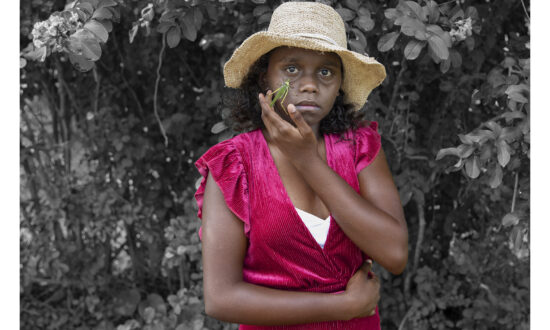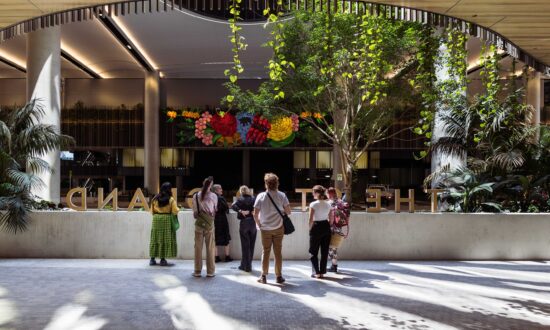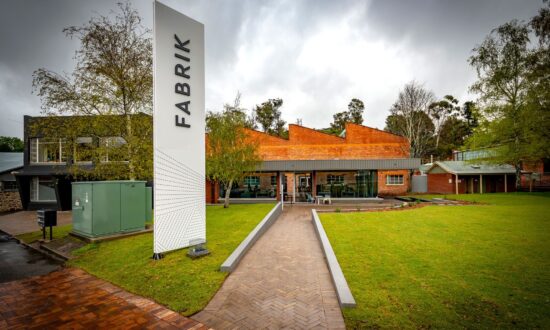Kate Just: Protest Signs
Min Wong: Purple Haze
Hugo Michell Gallery
Showing concurrently at Hugo Michell Gallery is Kate Just’s Protest Signs and Min Wong’s Purple Haze. While both artists explore the use of text as a form of power and influence, and the idea that a mantra is repeated to garner support and acknowledgement, they do so in very different ways. Just’s approach is political, and Wong’s is more a reflection of popular culture and behaviour.
Gleaned from images on social media, news media and real protests, Just’s body of work consists of hand-knitted images of protest signs mounted on canvas and wooden boards in the form of placards.
These placards lean against the gallery wall as if a protest has just happened and they are the signs left behind. The pieces are wonderfully crafted, and by using the medium of knitting Just is highlighting to the audience the love and commitment and labour put into making them.
While Just originally studied painting at the Victorian College of the Arts, in 2000 a personal tragedy led her home to the United States, where her mother taught her to knit. She was deeply affected by the potential of knitting and its ability to weave stories of love, loss and family, particularly the narrative of mothers and daughters passing down knowledge and information to each other.
Knitting has become Just’s primary medium through which she explores issues around feminism and the historical or fictional representation of women.

Kate Just, Another World is Possible, 2021, knitted wool, 77 x 92cm.
This exhibition continues Just’s engagement with the importance of social change and the idea that everybody can effect change. Protest signs are usually made quickly, viewed briefly and then often discarded after a protest and never looked at again. By re-creating them in the knitted form and presenting them in the gallery, she is expressing the importance of recording these “signs of our time” as a historical archive and recognising them as works of art. She has selected key focus points and created a more immersive tactile space for viewers to think about the emotional and physical investment people have in social change.
Even though Protest Signs deals with some difficult issues – such as violence against women, sexual harassment and racism – Just has managed to create a sense of hope and the potential for change. The strong topics are softened by the use of knitting and the emotional connection the audience has to it – it often makes people think of their grandmother or mother.
“I hope that people can see the knitting and the time and labour put into the work as a form of love. Like a love letter to the world that suggests that through this action it’s possible to imagine a different world,” she explains.

Min Wong, The struggle is real, 2021, neon, 20 x 200cm, edition of 5 + AP. Photo: Sam Roberts
Like Just, Wong is also concerned with ideas around collective consciousness and, in particular, how it can change the way we live our lives through being more aware of how we connect with ourselves, the collective and nature in a more altruistic way.
Drawing on experience and a genuine interest in an alternative way to interpret life, Wong’s practice examines the metaphysical and cultural esoterica of 1970s countercultures, New Age spirituality and a recent renewed interest in self-help and therapeutic culture. She is interested in the corporatisation of the self-care industry marketed at the individual rather than the collective, which taps into a pursuit for perfection.
Wong often takes text from gurus, New Age spirituality books and music, and recontextualises it. In Purple Haze she includes the phrase, The struggle is real, and presents it as a neon sculpture in glowing purple, the colour of consciousness, wealth and devotion.

Min Wong, Woo woo workout, 2021, steel, paint, brass, hinges, pyrite, hematite and smokey quartz, 160 x 160 x 70cm. Photo: Sam Roberts
The struggle is real features alongside the sculptural work Woo woo workout, which the artist refers to as “spiritual décor”. The sculpture becomes functional and domesticated because the viewer can use it in their home as a space to meditate, contemplate, and house objects for ritual. Also featured is the digital print My Body is a Temple, which references the corporate branding and marketing of the wellness industry.

Get InReview in your inbox – free each Saturday. Local arts and culture – covered.
Thanks for signing up to the InReview newsletter.
In both artists’ practices, the power of words and how they can influence and change lives is evident. Wong’s affirmations in neon and Just’s protest signs are both statements that reflect society and the current world we live in.
Kate Just’s Protest Signs and Min Wong’s Purple Haze are at Hugo Michell Gallery until May 7. Min Wong’s work is also currently on show at the Art Gallery of South Australia in the 2022 Adelaide Biennial of Australian Art: Free/State.
Support local arts journalism
Your support will help us continue the important work of InReview in publishing free professional journalism that celebrates, interrogates and amplifies arts and culture in South Australia.
Donate Here




